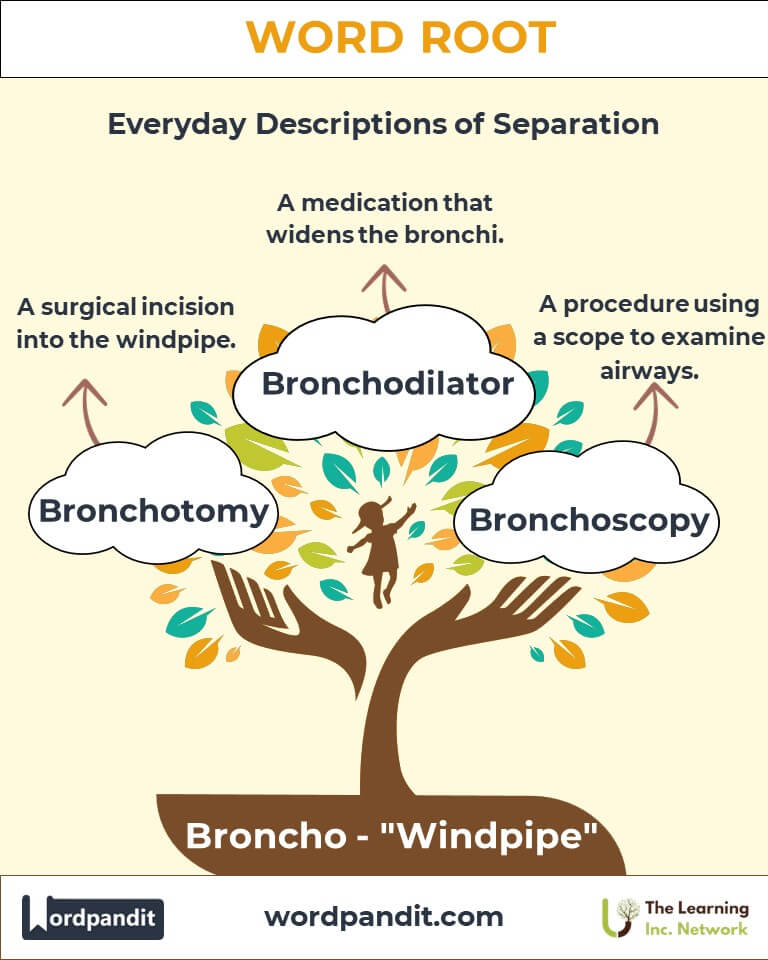Broncho: The Root of Breath in Medicine and Science
Byline: Delve into the root "Broncho", derived from the Greek word bronchos, meaning "windpipe." From common respiratory terms like bronchitis to specialized fields such as pulmonology, this root underscores the vital role of airways in life and health.

Table of Contents
- Introduction: The Breath of Broncho
- Etymology and Historical Journey
- Mnemonic: Remembering Broncho
- Common Broncho-Related Terms
- Broncho Through Time
- Broncho in Specialized Fields
- Illustrative Story: Broncho in Action
- Cultural Significance of Broncho
- The Broncho Family Tree
- FAQs about the Broncho Word Root
- Test Your Knowledge: Broncho Mastery Quiz
- Conclusion: The Living Legacy of Broncho
Introduction: The Breath of Broncho
The word root "Broncho" (pronounced bron-koh) originates from Greek, signifying the windpipe or airway. It serves as the cornerstone of terms that describe the respiratory system, its disorders, and treatments. From bronchitis, a common ailment, to bronchial tubes essential for breathing, this root is a linguistic and medical tribute to the airways that sustain life.

Etymology and Historical Journey
The root bronchos comes from ancient Greek, meaning "windpipe." It entered the medical lexicon via Latin during the rise of Western medicine. Over centuries, as knowledge of human anatomy expanded, the term evolved into bronchus in anatomical descriptions, forming the basis of numerous respiratory terms still used today.
Mnemonic: Remembering Broncho
Picture a tree where each branch (bronchus) extends and divides into smaller twigs (bronchioles), representing airways spreading through the lungs. This imagery captures the root's essence and its connection to the respiratory system.
Mnemonic Device: "Broncho branches through the lungs like a tree, carrying the breath of life."
Common Broncho-Related Terms
- Bronchitis (bron-KY-tis): Inflammation of the bronchial tubes.
Example: "The doctor prescribed antibiotics for her bronchitis." - Bronchial (BRONG-kee-uhl): Pertaining to the bronchi, the major air passages of the lungs.
Example: "Asthma affects the bronchial tubes, causing them to narrow." - Bronchodilator (bron-koh-DY-lay-tor): A medication that widens the bronchi.
Example: "The inhaler contained a bronchodilator to ease breathing." - Bronchoscopy (bron-KOS-kuh-pee): A diagnostic procedure using a scope to view the airways.
Example: "The bronchoscopy revealed no signs of infection." - Bronchiectasis (bron-kee-EK-tuh-sis): Permanent dilation of the bronchi due to damage.
Example: "Bronchiectasis can result from repeated respiratory infections."
Broncho Through Time
- Bronchotomy (Historical): A surgical incision into the windpipe, used in emergencies before modern tracheostomies.
- Bronchioles (Modern): Small branches of the bronchial tubes, reflecting advances in anatomical understanding.
Broncho in Specialized Fields
- Medicine: Bronchitis and bronchoscopy are essential in diagnosing and managing respiratory conditions.
- Pharmacology: Bronchodilators are critical in asthma and COPD treatments.
- Pulmonology: This field focuses on disorders of the bronchi and related structures.
Illustrative Story: Broncho in Action
Dr. Sofia Ramirez, a pulmonologist, was treating Carlos, a young athlete with severe asthma. During a bronchospasm episode, she administered a bronchodilator, instantly easing his breathing. Later, a bronchoscopy helped her identify a rare infection affecting his bronchioles. With precise treatment, Carlos regained his strength and returned to his passion for soccer, appreciating the care his airways required.
Cultural Significance of Broncho
The root Broncho not only defines medical terms but also symbolizes vitality, as clear airways are synonymous with health and energy. It reminds us of the importance of clean air and respiratory health in cultural narratives, public health campaigns, and daily life.

The Broncho Family Tree
- Pneumo- (Air, lung): Examples: Pneumonia (lung infection), Pneumothorax (collapsed lung).
- Pulmo- (Lung): Examples: Pulmonary (related to lungs), Pulmonology (study of lung diseases).
- Tracheo- (Windpipe): Examples: Tracheotomy (surgical incision in the windpipe), Tracheostomy (creating an opening in the windpipe).
FAQs About the Broncho Root
Q: What does “Broncho” mean?
A: Broncho originates from the Greek word bronchos, meaning "windpipe." It refers to the airways that branch from the trachea into the lungs, facilitating the flow of air for respiration.
Q: What is a bronchodilator?
A: A bronchodilator is a medication that relaxes the muscles around the bronchial tubes, widening the airways and improving airflow. These are commonly used to treat conditions like asthma and chronic obstructive pulmonary disease (COPD).
Q: How do bronchial tubes differ from bronchioles?
A: Bronchial tubes are the larger airways that branch directly from the trachea, while bronchioles are the smaller, finer branches that extend deeper into the lungs. Bronchioles lead to alveoli, where gas exchange occurs.
Q: Is bronchitis contagious?
A: Bronchitis can be contagious if it is caused by a viral or bacterial infection, as these pathogens can spread through droplets in the air. However, chronic bronchitis caused by factors like smoking is not contagious.
Q: What does a bronchoscopy involve?
A: Bronchoscopy is a diagnostic or therapeutic procedure where a flexible tube with a camera (bronchoscope) is inserted through the nose or mouth to examine the airways. It can detect infections, blockages, or abnormalities and is sometimes used to take biopsies.
Q: Why are the bronchi shaped like a tree?
A: The tree-like structure of the bronchi maximizes the surface area within the lungs, allowing for efficient air distribution and gas exchange. This design is crucial for supplying oxygen to the bloodstream and removing carbon dioxide.
Q: What is bronchiectasis?
A: Bronchiectasis refers to the abnormal and permanent dilation of the bronchial tubes, often due to chronic infections or inflammation. It leads to impaired mucus clearance, increasing the risk of infections.
Q: What causes bronchospasm?
A: A bronchospasm is a sudden tightening of the muscles around the bronchi, causing narrowing of the airways. It can be triggered by allergies, asthma, or irritants like smoke, making breathing difficult.
Test Your Knowledge: Broncho Mastery Quiz
1. What does the root "Broncho" signify?
2. Which condition involves inflammation of the bronchi?
3. What is a bronchoscopy primarily used for?
4. Which medication helps open the airways in conditions like asthma?
5. What are bronchioles?
Conclusion: The Vital Legacy of Broncho
The root Broncho exemplifies the intricate systems that keep us alive. From its ancient Greek origins to modern medical applications, it continues to shape our understanding of respiratory health. As research progresses, this root remains central to innovations in treating airway-related conditions, reinforcing its significance in language and life.












